| 2013 Roșia Montană Protests | |||
|---|---|---|---|
| Part of 2012–14 unrest in Romania | |||
 | |||
| Date | 1 September 2013 – 11 February 2014[1] (5 months, 10 days,) | ||
| Location |
| ||
| Caused by |
| ||
| Goals |
| ||
| Methods | |||
| Concessions |
| ||
| Number | |||
| |||
| Casualties and losses | |||
The Roșia Montană Protests were a series of protests in 2013 in Bucharest, Cluj-Napoca, Iași and dozens of other cities in Romania and abroad against the Roșia Montană mining project. Protesters said that the mining project would destroy the environment and heritage of Roșia Montană and demanded the withdrawal of a law which would enable this project to commence. In Bucharest, protests were held every evening in the University Square and marches were held each Sunday.
Although at first largely ignored by the world press, the demonstrations started to receive more significant worldwide attention both by the media and the general population via the use of social networks. The protests were dubbed the Indignants Movement (Romanian: Mișcarea Indignaților)[14] and Romanian Autumn (Romanian: Toamna Românească). by the Romanian press.[15][16]
Background
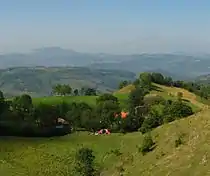
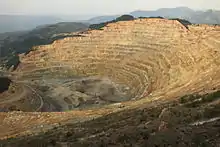
The Roșia Montană Project was initiated by Roșia Montană Gold Corporation, a company of which the largest shareholder is the Canada-based Gabriel Resources.[17] The company was given in 2000, without bidding, a license for mining gold.[18] The open-pit mining project proposed to use cyanide to extract gold and was expected to require the razing of three villages and destruction of four mountain tops.[19] It would have been Europe's largest open-pit gold mine, using 12,000 tonnes of cyanide yearly,[20][21] and yielding 350 tonnes of gold and 1,500 tonnes of silver.[19][22]
The Roșia Montană campaign was originally organized by locals of Roșia Montană who refused to be relocated and battled the corporation for years in the courts.[20] The activists claimed that the project would cause an environmental disaster, that it would destroy the ancient Roman archeological sites[19] and that the project involved handing assets to the Canadian company, while the Romanian state would earn only 6% out of the project.[23][24]
Within the last 14 years, the company was not able to obtain all the needed permits[20] due to failure to comply with the Romanian environment laws. The ruling Social Democrats made a campaign promise before the 2012 legislative elections to stop the project, but they changed their mind after winning the elections[25] In order for the project to continue, the Romanian government approved a new draft law in late August 2013 and forwarded it to the Parliament which had to vote on it in September.[17]
A concern was the fact that the legislation would give the Roșia Montană Gold Corporation the right to give compulsory purchase orders to the residents of Roșia Montană who refused to sell their houses and lands.[26] The draft law also sets time limits for the state authorities to grant all permits, regardless of potential infringements of national legislation or of court rulings.[20]
Protests
The protests tend to follow a weekly pattern, with the first day of protests, Sunday, 1 September being the starter for this routine. To this day, all over the country the major protests are held on Sundays, with the weekdays being reserved for local or minor protests, the Saturdays for mass alternative ways of spreading information about the protest and the Sundays peaking with the most people joining in all major cities. Since its beginning, every major Sunday protest has grown exponentially in numbers.
The protests were organized in cities across the country, with thousands of people in Bucharest and Cluj-Napoca. Protests were held across Europe, with an estimated 150–200 Romanians and environmentalists protesting in London.[26] The protests, organized during the evenings, involved the protesters blocking streets, drumming, singing and organizing sit-ins in the street.[25][26] In Berlin and Brussels (in front of the UNESCO Headquarters), the protests included a die-in. In Chicago, members of the Romanian community, solidary with the Roșia Montană protest movement, joined a spontaneous protest inside the consulate in Chicago. The protest took place at the Romanian Prime Minister's visit to the United States. People have made an open letter to Prime Minister Victor Ponta, through which they demand the ban of cyanide mining and shale gas exploitation in Romania.[27]
Some protesters called upon President Băsescu's and Prime-Minister Ponta's resignations, both politicians being supporters of the project.[19][28]
The 'Save Roșia Montană' campaign is now regarded as the largest civic movement in Romania since the 1989 revolution.[14][29]
Rallies
Rallies are held every evening in Bucharest's University Square. They result every time in traffic delays.
On Tuesday, 10 September, in the middle of the street, in front of the university, a string quartet played to the protesters classical and modern music, including Metallica's "Nothing Else Matters".[30] The following Tuesday, near the fountain next to the university, a group of 50 dancers organized a flash mob dancing tango.[31]
On 21 September, nearly 7,000 people formed a human chain around the Palace of the Parliament. They were joined by thousands of cyclists, that marched around the building.[32]
On 4 October, several paragliders from Cluj jumped from height at Dezmir Aerodrome, displaying messages for the salvation of Roșia Montană. They were joined by dozens of young people coming to protest.[33]
Great Gathering and Proclamation of Câmpeni
More than 5,000 residents of Câmpeni, Alba County, gathered in city's centre to protest against cyanide mining project at Roșia Montană and against the Ponta Government. They were joined by thousands of activists from all major cities of the country.[34] People are outraged because declarations of PM Victor Ponta who argued that in Câmpeni would protest extremist groups and that authorities are prepared to intervene.[35] They accuse the entire political class of manipulation and betrayal.[36]
The organizers of this event, supported by protesters, drew up a proclamation with clear and concise claims.
- Rejection by Parliament of all draft laws that provide special measures for the expropriation of Romanian citizens, and other measures derogating from the statutory of protection of environment, cultural heritage, water, meadows and agricultural land, public goods etc., in behalf of mining companies of any kind;
- Legal prohibition of the use of cyanide in mining activities in Romania;
- Inclusion of Roșia Montană on Romania's tentative list for UNESCO;
- Rejection of emergency, by Government Decision, of the environmental permit for the mining project in Roșia Montană;
- Declassification of all contracts and addenda signed by the Government, concerning alienation, lease and concession of Romania's mineral resources;
- Resignation of initiators of special bill for Roșia Montană: Minister of Great Projects, Dan Șova, Environment Minister, Rovana Plumb, Minister of Culture, Daniel Barbu, Director of the National Agency for Mineral Resources, Gheorghe Duțu, and Prime Minister Victor Ponta;
- Assumption by the Government of expertise and views on mining project in Roșia Montană expressed by: Romanian Academy, Ad Astra Association, Romanian Geological Institute, Order of Architects of Romania, Synod of the Romanian Orthodox Church, Synod of the Romanian Church United with Rome, Greek-Catholic and the other Christian churches in Romania, as well as independent experts;
- Creation of a Parliamentary Commission of Inquiry on Roșia Montană Project in all aspects: alienation of deposits; sponsorship of RMGC by public and private institutions, NGOs, individuals; influencing policy decisions; infringement of final judgment; manner in which advertising provided by the company affected press freedom and freedom of expression etc.;
- Restoration and development of road infrastructure in the Apuseni Mountains and granting of tax incentives and other economic development activities in the following domains: tourism, woodworking and forest restoration, growing and processing of animal products, apiculture, other activities specific to the area;
- Adoption by the Romanian Government of public policies, as development, with the aid of real civil society, of a strategy that provides measures in line with sustainable development, optimal use of resources, preservation of cultural and historical heritage and supporting local entrepreneurs;
- Beginning by authorized institutions of criminal investigation in case of the people who have signed or participated in the development and approval of documents concerning the mining project in Roșia Montană;
- Legal prohibition of the use of hydraulic fracturing method in shale gas exploitation and respecting, in target areas for this operation, the sovereign will of citizens, wherewith we express our full solidarity.
Proclamation of Câmpeni – 19 October 2013, rosiamontana.org
Marches

As the media, particularly the TV stations, failed to cover properly the protests, the protesters marched each Sunday for hours throughout the neighbourhoods of Bucharest in order to spread the word of the protests.[20]
Also, slogans opposing the ongoing project of shale gas fracking were shouted and bystanders were invited to join. On 15 and 22 September, tens of thousands of protesters took to the streets again, including more than 22,000 in Bucharest.[20]
Incidents
Although the protests are generally peaceful in conduct, some incidents were reported. In the first day of protests, a group of protesters tried to break into the government headquarters, but were stopped by gendarmes. Some teenagers who had joined the protesters jostled with law enforcement officers and threw firecrackers.[37] In Cluj-Napoca, protesters lit smoke-producing objects. In Bucharest, Timișoara and Iași, protesters installed tents on the roads, blocking the traffic on major arteries of circulation.[38]
The Minister of Culture, Daniel Barbu, was attacked by protesters with tomatoes in front of the prefecture in Cluj-Napoca on 13 September.[39] The crowds demanded the resignation of the minister and displayed banners that read "Barbu, gold mercenary, against the patrimony" and "Roșia Montană in UNESCO". One of the protesters was forcibly removed from the minister's car by gendarmes.[40] A similar incident took place in Bucharest historical centre, on 17 October, when Barbu faced an angry crowd after a debate in Club A. Protesters booed Barbu, who yelled at them "You're neofascists". After he got into his car, the windshield was broken when he closed the door. According to Barbu, this was due to stones thrown by protesters, but according to other reports, the windshield had been cracked beforehand, presumably by protesters.[41] Following the incident three protesters were arrested[42] and 40 others heard at local police station.[43]
On 25 September, a group of 1,000 protesters gathered in front of a restaurant in Câmpeni, Alba County where the members of the Parliamentary Commission for Roșia Montană were dining, preventing them from getting out of its courtyard. Their minivan was able to exit following an intervention of the gendermes.[44]
Those attending the protests accuse the authorities of initiating repression against protesters, after, on 27 October and 3 November, protesters in Bucharest, Brașov and Cluj-Napoca were hit and sprayed with irritant substances by gendarmes.[45][46] Some of the anti-Roșia Montană demonstrators revealed by documents the aggressions of law enforcement and pressures they made (large fines, threats, etc.) to end anti-government protests.[47]
On 9 December, about 50 Greenpeace activists from 10 countries entered the courtyard of the Parliament building and began to "dig for gold", displaying banners with the message "Gold mining area".[48] Activists were seized by gendarmes and led to the sections 17 and 18 of the Police.[49]
Protesters' profile
The protesters belonged to a wide range of social strata: students, teachers, priests, activists, artists, engineers, retired and unemployed people.[50] They did not share a common ideology, but rather being a heterogenous mix of left and right wing-oriented people, including conservatives, libertarians, socialists, anticapitalists, nationalists, conspiracy theorists etc.[51] Due to a vast majority of the protesters being young professionals, the protests have on occasion been called, both by its critics and its supporters, "the protest of the hipsters".[52]
Although there were relatively few, the existence of anti-capitalist young people among the protesters surprised many commentators. Dan Tapalagă of Hotnews argues that for people of his generation (who overthrew the Communist Party), it is hard to understand what the young people are thinking.[53] Marius Ghilezan of Evenimentul Zilei blamed the parents for "failing to give their children a pro-capitalist view".[54]
The protests had a non-hierarchical nature and no official leaders and have been organized through Facebook.[20]
According to sociologist Mircea Kivu, while during the first day of protests as many as 90% of the protesters were young, as the number of participants increased the following Sundays, the percentage of young people decreased to two-thirds.[50]
Participants
Princess Brianna Caradja, a declared opponent of the mining project, was among those who joined the protests in Bucharest. She also took part in the nationwide protests in 2012. Other public figures participating in the demonstrations were the PDL deputy Theodor Paleologu, who said he would oppose the project at the vote in Parliament, and the vocalist of rock band Luna Amară, Mihnea Blidariu.[55]
Csibi Magor, Romania Program Director of World Wide Fund for Nature, Claudiu Crăciun, lecturer at the Faculty of Political Sciences, Remus Cernea, a well-known activist, and Cristian Neagoe, consultant at Cărturești Foundation were among those present during the protests in University Square.[56]
Media portrayal

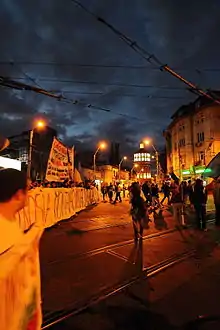
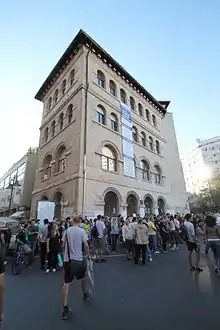
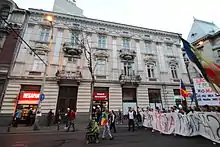
Protesters accused the Romanian media of a media blackout, claiming that this was due to the fact that Gabriel Resources paid large sums of money in advertising throughout the years.[50] According to Forbes Romania, Roșia Montană Gold Corporation paid 5.4 million €-worth (rate card prices) of advertising in the Romanian newspapers during the last three years[57] and about €550,000 in TV ads last year.[58]
On 7 September, thousands of protesters marched to the publicly funded Romanian Television (TVR) headquarters to protest against the TVR's blackout, but this protest was not featured in its news program, either.[59]
With the exception of the national television channel Digi24,[60] the first week of protests went uncovered in almost all mainstream mass-media, which led to a strong negative reaction in the protesters.
As the protests became larger, it became impossible for the media to ignore the events. Still, the press was continuously criticised of presenting the news in a biased or distorted manner, in ways such as grossly minimising the activists' number to suggest the existence of a minor revolt or making use of TV personalities such as the popular media figure Mircea Badea to present the protesters as a mass of disoriented people with no defined purpose.[61]
Some media outlets accused the protesters and environmentalists of financial gains. For instance, TV show host Mihai Gâdea of Antena 3 (Romania) accused Horia-Roman Patapievici of being a real estate speculator for owning land in Roșia Montană.[62] Patapievici replied in an open letter that he owns only 1 square meter, as a symbol of solidarity with the people of Roșia Montană and that it is not a real estate investment.[62] Evenimentul Zilei accused the "cunning NGO activists" involved in the protests of receiving money from foreigners (such as George Soros's Open Society Foundations) and using the money to organize the protests.[63] Likewise, Mihai Gâdea has addressed, in one of his shows, an insulting message to opposers of the Roșia Montană Project in University Square. He called protesters "Băsescu's slaves", adding that "many of you don't know because of ketamine, high ketamine impedes you understanding things."[64] He later defended himself, arguing that he did not insult all the protesters.[65] More than that, both Mihai Gâdea and Mircea Badea were threatened on Facebook by angry protesters.[66]
The protesters chanted against what they perceived as the corruption of press. Evenimentul Zilei claimed that this is part of a "campaign of disinformation" which intends to "discredit the mainstream media".[63]
Concessions
President Băsescu mentioned the possibility of having a national referendum regarding the Roșia Montană project, but later on he clarified that it is just a possibility, not that he's starting a referendum. On 16 September, President Traian Băsescu asked Prime-Minister Ponta to withdraw the law from the Parliament, arguing that it has clauses that breach the constitution and predicting that, if it passes, it would be rejected by the Constitutional Court of Romania.[67]
On 9 September, Prime-Minister Victor Ponta predicted that the Romanian Parliament would reject the law and that the government would try to find other ways to increase jobs for that area.[68][69] This news led to a fall of 48% of the shares of Gabriel Resources on the Toronto stock exchange[68] and threats from the company to sue the Romanian state for damages of $4 billion if the law does not pass the Parliament.[70]
Nevertheless, PM Ponta changed his mind the following weeks, at first arguing that not doing the project "would not be a big loss for Romania"[71] and a week later that it "would be a negative signal to foreign investors" and hence, "a catastrophe for Romania".[72]
Crin Antonescu, the leader of the National Liberal Party, announced that his party opposes the project.[23][73]
On 19 November, the Senate rejected the bill on Roșia Montană, in the form submitted by the Government.[74] The Senate adopted with 119 votes "for", three votes "against" and six abstentions, the Report elaborated by the Special Parliamentary Commission on Roșia Montană Project, that proposed the rejection of the bill as passed by the Government.[75][76] The commission recommended a new draft law for all mining in the area.[77]
Reactions
Former Minister of Culture Răzvan Theodorescu claimed that the protests are "a dangerous beginning" and that the counterculture is dangerous for Romania because the protesters oppose all parties, which he argues to be "the representatives of the Romanian people".[78] Former President Ion Iliescu dismissed the protesters as people "don't know a great deal" about the project and that they're acting like "19th century poets horrified by industry".[79]
Historian Vladimir Tismăneanu applauded the protests, arguing that "civic mobilization can stop government actions that are dangerous for the society" and that "the spirit of 1990 University Square is back".[80]
On 4 September, Crown Princess Margareta of Romania transmitted, through a communique, the position of the royal family to the Roșia Montană Project. Royal House of Romania, alongside the Romanian Academy, the Catholic and Orthodox churches and the civil society,[81] supports, in every way possible, safeguarding and flowering virtues and values of Roșia Montană, opposing the destruction of nature through gold cyanidation.[82]
Victoria Stoiciu, an analyst at the Friedrich Ebert Foundation, considers that these manifestations are "an unprecedented phenomenon since the 1990s" and they are breaking the "suffocating civic apathy in Romania".[83]
Adrian Sobaru, Romanian Television employee who in 2010 jumped from the balcony of the Chamber of Deputies in protest against austerity measures promoted by Emil Boc Government, decided, on 10 September, during his child's birthday, to go on hunger strike.[84] He calls for depoliticization of public television, public radio and other important state institutions, solutions for Roșia Montană problem and compliance with all promises made by USL leadership during the electoral campaign.[85] MediaSind Romanian Federation of Journalists solidarized with protests triggered by Adrian Sobaru and will inform the European Federation of Journalists, the International Federation of Journalists, the European Parliament and the European Commission about the manner in which Ponta Government will address the issues raised by Adrian Sobaru.[86]
In a press conference, President of the Senate, Crin Antonescu, said that the Roșia Montană Project can not be sustained, considering also that the contrary public sentiment is more important than technical data.[87] Likewise, the mayor of Cluj-Napoca, also former premier, Emil Boc, said on 4 September, in a press conference, that calls on the Government to withdraw the law on RMP, because is unconstitutional. Boc argues that it offers to a private company public powers that must belong only to the Government or public authorities.[88] The same opinion was adopted by President Traian Băsescu, who also expressed his desire to pass responsibility for the project to state agencies.[89] Liberal MEP Renate Weber said that she's ready to represent the Romanian State in a possible trial with Roșia Montană Gold Corporation, arguing that the company is one of the type "hit and run".[90][91]
On 24 September, Mihăiță Calimente, the head of the Foreign Intelligence Service Parliamentary Commission, claimed that ONGs financed by Soros acted like a catalyzer in the protests and that they can be "a danger for national security".[92]
Greenpeace Romania announced on its official page that over 13,000 people ask lawmakers not to approve the "disastrous" bill for Roșia Montană.[93]
According to Oxford Analytica, the protests have plunged the government into disarray and may bring it down.[94]
Involvement of the Romanian Intelligence Service
The Director of the Romanian Intelligence Service, George Maior and the Director of the Foreign Intelligence Service, Teodor Meleșcanu, were heard, on 30 September, by the parliamentary oversight commission on the subject of Roșia Montană.
George Maior stated that the Roșia Montană Project is a matter of national security,[95][96] warning that some "eco-anarchist structures" might attempt to hijack the legitimate protest movements on the issue.[97] He stressed that the Service has submitted, during 1999–2013, 500 informative notices on this topic, emphasizing that the institution he leads can not rule on whether the project will be implemented.[98]
On the same day, the Delegate Minister for Infrastructure Projects of National Interest and Foreign Investment, Dan Șova, was heard saying that the operating license for the Roșia Montană mining activities was granted to RMGC at the request of Canadian banks and the stock exchange.[99] Șova also said that the Romanian state would be obliged to give approval to RMGC to start mining operations at Roșia Montană, otherwise the company would appeal to the International Court of Arbitration.[100]
Protests in favor of the mining project
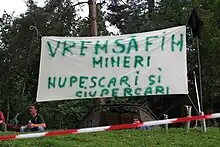
Protests in favor of the mining project took place in Roșia Montană and surrounding localities, but at a lesser scale, their number not surpassing a few hundreds.[101] They were largely orchestrated by RMGC themselves with the support of local administrations.[102][103] 33 workers had blocked themselves into the Roșia Montană museum shafts 300 metres below ground and threatened to go on hunger strike over fears jobs would be lost if the mining plans did not go ahead. They demanded the presence of Prime Minister Victor Ponta and PNL leader Crin Antonescu. On 15 September, the Prime Minister descended into the underground to discuss with the protesters, resulting in the end of their strike.[104][105]
Ion Cristoiu, in an op-ed in Evenimentul Zilei, argued that Ponta's descent to the mine was a "disgusting show", reminding of Nicolae Ceaușescu's propaganda and that Victor Ponta was simply an actor in a Roșia Montană Gold Corporation ad.[106]
With the occasion of Miner's Day, 50 mayors in the Apuseni Mountains have sent to governors and lawmakers a call asking them to allow commencement of gold mining project in the village.[107][108]
On 25 September, independent MP Remus Cernea and two other German environmentalists went to Roșia Montană to dialogue with supporters and opponents of the mining project. The three were aggressed by angry mobs.[109] They were evacuated by police as they would have risked being lynched by residents and supporters of the project.[110] Remus Cernea was trying to take part in discussions between the Parliamentary Commission and the syndicalists in the area.[111]
In an interview accorded to Pro TV, a Romanian television program, President Traian Băsescu said that the protest at Roșia Montană, pro-RMGC, is forged.[112] The Head of State also said that he doesn't like "to pretend that we enter into tourist galleries and say that we are the underground miners".[113]
See also
References
- ↑ "The RMGC Special Law Must Not Pass! (Romanian)". Facebook.
- ↑ "Cyanide Compounds". U.S. Environmental Protection Agency. Retrieved 8 October 2013.
- 1 2 3 4 5 6 7 McGrath, Stephen (18 October 2013). "Rosia Montana and Dirty Politics". The Huffington Post. Retrieved 27 October 2013.
- ↑ M., R. (16 October 2013). "Directorul Institutului Geologic al Romaniei (IGR), Stefan Marincea: Am fost demis prin fax. Am cerut desecretizarea unor documente legate de Rosia Montana care erau falsuri, probabil ca nu trebuia sa ajung la ele". Hotnews.ro. Retrieved 18 October 2013.
- ↑ "RMGC: Licence to exploit Rosia Montana project is secret, according to Romanian law". Agerpress. Retrieved 8 October 2013.
- ↑ Zancu, Adina. "Vezi cum va vota parlamentarul tău în proiectul Roşia Montană". Evenimentul. Retrieved 8 October 2013.
- ↑ Ciobanu, Rodica (19 October 2013). "Victor Ponta nu mai vede poporul de atâția "anarhiști și legionari"". Gândul.
- ↑ "Roșia Montană. Protestatarii boicotează Comisia specială: "Revendicările sunt clare"". Cotidianul.ro. 26 September 2013. Retrieved 30 September 2013.
- ↑ Martin, Iulia (10 December 2013). "Legea minelor, respinsă în Parlament. PNL a înclinat balanța". Adevărul.
- ↑ Besliu, Raluca (21 October 2013). "Romania on fire: The Romanian Autumn expands". CNN iReport.
- ↑ Pele, Alexandra; Vârlan, Corina (22 September 2013). ""INDIGNAȚI-VĂ!" Peste 20.000 de persoane au protestat în București împotriva proiectului de la Roșia Montană, dar și împotriva clasei politice. Un bărbat a fost arestat". Gândul. Retrieved 30 September 2013.
- ↑ Stoica, Mihai (18 November 2013). "62 de persoane au fost amendate la protestul față de proiectul minier "Roșia Montană" de duminică după ce au blocat circulația". Adevărul.
- ↑ Ciliac, Alexandra; Breazu, Sorin; Botezatu, Cristina (28 October 2013). "Miting ANTI-ROȘIA MONTANĂ. O femeie a leșinat în timpul protestului de aseară". Evenimentul Zilei.
- 1 2 Marian, Mircea (11 September 2013). "Elena Udrea: "Indignații noștri, pe zi ce trece mai mulți, nu reprezintă doar lupta împotriva exploatării de la Roșia Montană"". Evenimentul Zilei. Retrieved 8 October 2013.
- ↑ Dumitru, Elena (7 September 2013). "CNN: "Primăvara Arabă, Vara Turcească, Toamna Românească. Protestele românilor, un model de demonstraţii paşnice"". Adevărul. Retrieved 8 October 2013.
- ↑ "CNN despre protestele pentru Roşia Montană: "Toamna românească", un moment istoric". Realitatea.net. 8 September 2013. Archived from the original on 15 October 2013. Retrieved 8 October 2013.
- 1 2 "Romania gold project at Rosia Montana back on track". BBC. 28 August 2013. Retrieved 10 September 2013.
- ↑ "There's something rotten in Bucharest: protests turn political in Romania". Global Post. 27 September 2013. Retrieved 27 September 2013.
- 1 2 3 4 "Romanians protest for second day against gold mine". The Guardian. 10 September 2013. Retrieved 3 September 2013.
- 1 2 3 4 5 6 7 "Romanians mobilise in protest against gold mine plans". The Guardian. 17 September 2013. Retrieved 17 September 2013.
- ↑ (in Romanian) "Memoriu de prezentare a proiectului Roșia Montană" Archived 31 March 2010 at the Wayback Machine, Ministry of Environment and Climate Change
- ↑ Gener, Randy (25 September 2013). "Europe's Ecological Time Bomb: Roșia Montană Gold Mine in the Hills of Romania". The Journalist. Retrieved 25 September 2013.
- 1 2 Dadacus, Liviu (20 September 2013). "Decizia finală care nelinişteşte USL. "În Parlament, PNL va vota împotriva proiectului Roşia Montană"" [USL troubling final decision. "In Parliament, Liberal Party will vote against RMP"]. Gândul (in Romanian). Retrieved 20 September 2013.
- ↑ "Documentele confidențiale ale afacerii Roșia Montană". Rise Project (in Romanian). 31 August 2013.
- 1 2 Dale-Harris, Luke (20 September 2013). "Romania's Powder Keg: Mine Project Launches Protest Movement". Der Spiegel. Retrieved 22 September 2013.
- 1 2 3 "Protests continue in Bucharest against gold mine plan in Rosia Montana". The Guardian. 4 September 2013. Retrieved 10 September 2013.
- ↑ "Protest spontan la Consulatul României din Chicago, cu ocazia vizitei lui Victor Ponta în SUA". B1.ro. 23 October 2013.
- ↑ Odobescu, Vlad; Ciorniciuc, Radu (27 September 2013). "There's something rotten in Bucharest: protests turn political in Romania". Global Post. Retrieved 1 October 2013.
- ↑ Romocea, Oana (13 September 2013). "Who is Roşia Montană? – or the Dawn of A New Generation". The Huffington Post. Retrieved 8 October 2013.
- ↑ "String quartet plays Metallica for Romanian protesters". Yahoo! News. 10 September 2013. Retrieved 24 September 2013.
- ↑ "Dansatori de tango, într-un flashmob, la protestul privind Roşia Montană de la Universitate". Gândul. 18 September 2013. Retrieved 24 September 2013.
- ↑ "Thousands of Romanians form human chain to protest gold mine project". Fox News. 21 September 2013. Retrieved 21 September 2013.
- ↑ Romitan, Claudia (4 October 2013). "Protest la înălțime pentru Roșia Montană". Transilvania Reporter. Retrieved 4 October 2013.
- ↑ Popa, Sorin (19 October 2013). "Marea adunare a moților împotriva proiectului minier de la Roșia Montană". Cotidianul.
- ↑ "Victor Ponta: Am văzut că e un grup extremist care încearcă să creeze o provocare și violență la Câmpeni. Vom lua măsuri". HotNews.ro. 19 October 2013.
- ↑ "Marea Adunare de la Câmpeni: "Toate partidele fură prin rotație"". Nașul TV. 19 October 2013. Archived from the original on 21 October 2013. Retrieved 20 October 2013.
- ↑ "Protest în centrul Capitalei: Mii de persoane cer demisia Guvernului și militează pentru salvarea Roșiei Montane". B1.ro. 1 September 2013.
- ↑ "Proteste pentru Roșia Montană: "Ieșim în stradă ca în '90. Suntem oameni inteligenți, nu disperați"". Ziare.com. 2 September 2013.
- ↑ "Atac cu roşii la Roşia Montană. Ministrul Culturii, asaltat de protestatari". Antena 3. 13 September 2013. Retrieved 25 September 2013.
- ↑ "Ministrul Culturii, Daniel Barbu, atacat cu roșii la Cluj". Digi24. 13 September 2013. Retrieved 25 September 2013.
- ↑ "Daniel Barbu către protestatarii Roșia Montană: "Sunteți neofasciști"". VICE. 18 September 2013. Retrieved 25 September 2013.
- ↑ Dinu, Clarice (17 October 2013). "Ministrul Culturii, Daniel Barbu, ATACAT CU PIETRE în centrul Capitalei de manifestanții anti-Roșia Montană. Mașina ministrului, vandalizată". Gândul.info.
- ↑ Cojocariu, Mihaela (21 October 2013). "Peste 40 de persoane au fost audiate în cazul atacului asupra ministrului Barbu. Autorul – identificat, dar nu este reținut". Adevărul.
- ↑ "Comisia Roşia Montană, la o întâlnire la Câmpeni cu opozanţii proiectului. Parlamentarii, împiedicaţi să iasă din local de 1.000 de persoane". Mediafax. 25 September 2013.
- ↑ "ROȘIA MONTANĂ, violențe la Brașov. Protestatar bătut de jandarmi: "Am încasat cât au vrut"". Realitatea.net. 28 October 2013. Archived from the original on 9 November 2013. Retrieved 8 November 2013.
- ↑ Goțiu, Mihai (4 November 2013). "Martor ocular la violențele jandarmilor de la Cluj. VIDEO cu un șef de jandarmi isteric". Vox Publica.
- ↑ Ciocăzanu, Laurențiu (30 October 2013). "Revoluția începe la Nașul TV. Protest pe trotuar și mobilizare pe axa București-Brașov". Reporter Virtual. Archived from the original on 2 November 2013. Retrieved 4 November 2013.
- ↑ Ofițeru, Andreea (9 December 2013). "Protest Greenpeace față de legea minelor, la Palatul Parlamentului. Activiștii au fost ridicați de Poliție". Gândul.
- ↑ "Zeci de activiști Greenpeace au protestat săpând în curtea Parlamentului și au fost ridicați de jandarmi". HotNews.ro. 9 December 2013.
- 1 2 3 "Golden profits v environmental concerns". The Economist. 6 September 2013. Retrieved 10 September 2013.
- ↑ Pepine, Horațiu (12 September 2013). "Ecologia, victimă fără vină". Deutsche Welle (in Romanian). Retrieved 17 September 2013.
- ↑ "Define: Hipster". VICE. Retrieved 10 February 2015.
- ↑ Tapalagă, Dan (3 September 2013). "Ce am vazut la protestul anti-Rosia Montana". Evenimentul Zilei. Retrieved 18 September 2013.
- ↑ Ghilezan, Marius (17 September 2013). "Genetica protestelor din Piaţa Universităţii". Evenimentul Zilei. Retrieved 18 September 2013.
- ↑ "A doua zi de PROTESTE la Universitate față de proiectul "Roșia Montană"! "Nu ne tratați cu cianURĂ!"". Libertatea. 2 September 2013. Retrieved 4 October 2013.
- ↑ "Sinteza Zilei: Unul dintre protestatarii din Piața Universității explică de a ieșit în stradă". Antena3.ro. 9 September 2013. Retrieved 4 October 2013.
- ↑ "Câți bani a cheltuit Roşia Montana Gold Corporation în publicitatea din presa scrisă". Forbes Romania. 2 September 2013. Retrieved 14 September 2013.
- ↑ "Televiziunile pe care Roșia Montana Gold Corporation a consumat publicitate". Forbes Romania. 5 September 2013. Retrieved 14 September 2013.
- ↑ "Mii de oameni au protestat la poarta TVR, iar Televiziunea publica nu a prezentat nicio o secunda manifestatia in programele sale". Revista 22. 8 September 2013. Retrieved 10 September 2013.
- ↑ "Ce spune "presa română plină de minciună" despre proteste – Casa Jurnalistului". Casa Jurnalistului. 8 September 2013. Retrieved 10 February 2015.
- ↑ Țene, Ionuț (4 September 2013). "De ce nu sunt de acord cu Mircea Badea. La Roșia Montană nu poți fi neutru". Napoca News. Retrieved 4 October 2013.
- 1 2 Horia-Roman Patapievici (13 September 2013). "Drept la replică". Dilema Veche. Archived from the original on 15 September 2013. Retrieved 14 September 2013.
- 1 2 Bot, Mălin (14 September 2013). "Cum manipulează şmecherii din ONG-uri Piaţa Universităţii şi cât de toxică e dezinformarea". Evenimentul Zilei.
- ↑ Neagu, Alina (29 September 2013). "Mihai Gâdea, jigniri și amenințări către protestatarii din Piața Universității: Ketamina voastră, urina prietenei, a prietenului, vă împiedică să înțelegeți. Sunteți sclavii lui Băsescu. Plus: Nu-i iritați pe oamenii care iubesc postul acesta de televiziune, nu știi de unde te lovește". HotNews.ro (in Romanian). Retrieved 4 October 2013.
- ↑ "Drept la replică. Mihai Gâdea susține că nu a jignit protestatarii". HotNews.ro (in Romanian). 30 September 2013. Retrieved 4 October 2013.
- ↑ Alexandrescu, Cristina (23 September 2013). "Imagine cutremurătoare cu Badea și Gâdea, după amenințarea cu moartea". DC News. Retrieved 4 October 2013.
- ↑ "Traian Basescu, despre legea privind Rosia Montana: Cea mai buna solutie e ca guvernul sa retraga urgent proiectul din parlament". Hotnews. 16 September 2013. Retrieved 16 September 2013.
- 1 2 Muttler, Allison (9 September 2013). "Romanian PM: No support for gold mine". The Boston Globe. Archived from the original on 27 September 2013. Retrieved 10 September 2013.
- ↑ Savu, Irina (9 September 2013). "Romania's Ponta Urges Vote to Reject Gold Mine Project". Bloomberg Television. Retrieved 22 September 2013.
- ↑ "Paulson-Backed Gabriel Threatens $4 Billion of Claims in Romania". Businessweek. 11 September 2013. Archived from the original on 14 September 2013. Retrieved 15 September 2013.
- ↑ "Victor Ponta: Daca nu facem proiectul Rosia Montana nu e o mare problema pentru Romania". Hotnews. 17 September 2013. Retrieved 25 September 2013.
- ↑ "Victor Ponta: Respingerea proiectului Rosia Montana – mesaj impotriva investitorilor, ceea ce ar fi o "catastrofa" pentru Romania". Hotnews. 25 September 2013. Retrieved 25 September 2013.
- ↑ "Romania: ecological protests cause tensions within the government coalition". Centre for Eastern Studies. 18 September 2013. Archived from the original on 27 September 2013. Retrieved 27 September 2013.
- ↑ "Plans for Europe's biggest open-cast gold mine in Romania are thrown out". Euronews. 11 November 2013.
- ↑ "Proiectul Roșia Montană, respins în Senat". Antena 3. 19 November 2013.
- ↑ "Romania's Senate rejects Canadian gold mine". Yahoo! News. 19 November 2013.
- ↑ "Romanian commission set to reject gold mine project". Reuters. 11 November 2013.
- ↑ "Răzvan Theodorescu: Lehamitea tinerilor nu trebuie să se transforme într-o mișcare extremistă". Realitatea. 9 September 2013. Archived from the original on 11 September 2013. Retrieved 10 September 2013.
- ↑ "ROŞIA MONTANĂ: Iliescu îi atacă pe protestatari". România Liberă. 9 September 2013. Archived from the original on 11 September 2013. Retrieved 10 September 2013.
- ↑ Vladimir Tismăneanu, Piata Universitatii, Rosia Montana si puterea celor fara de putere: Renasterea polisului paralel, 9 September 2013
- ↑ Olteanu, Alina (4 October 2013). "Biserica şi Academia Română, împotriva proiectului Roşia Montană". Ziua News. Retrieved 4 October 2013.
- ↑ "Poziţia Familiei Regale a României faţă de proiectul de la Roșia Montană". Știrile TVR. 4 September 2013. Retrieved 4 October 2013.
- ↑ "Mass protests in Romania join 'Balkans-wide wave'". Hürriyet Daily News. 15 September 2013. Retrieved 22 September 2013.
- ↑ "Adrian Sobaru a intrat în greva foamei". Antena3.ro. 10 September 2013. Retrieved 30 September 2013.
- ↑ Tudor, Iulian (10 September 2013). "Adrian Sobaru, angajatul TVR care s-a aruncat de la balconul Parlamentului, în GREVA FOAMEI". România TV. Retrieved 30 September 2013.
- ↑ "Adrian Sobaru a intrat în GREVA FOAMEI. Federaţia Română a Jurnaliştilor se SOLIDARIZEAZĂ". Realitatea.net. 10 September 2013. Archived from the original on 15 October 2013. Retrieved 30 September 2013.
- ↑ "Antonescu: Proiectul Roșia Montană nu poate fi susţinut". Cotidianul. 9 September 2013.
- ↑ Pop, Florina (4 September 2013). "Primarul Clujului cere Guvernului să retragă proiectul de lege despre Roşia Montană". Adevărul. Retrieved 22 September 2013.
- ↑ "Băsescu: Legea privind proiectul Roşia Montană este NECONSTITUŢIONALĂ. Ar trebui să merg la Roşia Montană". Antena 3. 15 September 2013. Retrieved 22 September 2013.
- ↑ "ROŞIA MONTANĂ. Renate Weber, gata să reprezinte gratis statul român într-un proces cu RMGC". Realitatea. 11 September 2013. Archived from the original on 26 September 2013. Retrieved 22 September 2013.
- ↑ "Renate Weber la RFI, despre Roşia Montană: Situl arheologic nu merită distrus pentru exploatarea auriferă!". Radio France Internationale. 12 July 2013. Retrieved 22 September 2013.
- ↑ "Şeful Comisiei SIE din Parlament: "ONG-urile lui Soros sunt catalizatorul Pieţei Universităţii. Finanţările acestora pot reprezenta un pericol pentru siguranţa naţională"". Gândul. 24 September 2013. Retrieved 24 September 2013.
- ↑ "Cere parlamentarilor să nu aprobe proiectul de lege pentru Roșia Montană!". Greenpeace.org. Archived from the original on 27 September 2013. Retrieved 24 September 2013.
- ↑ "Gold mine may bring down government". The Oxford Analytica Daily Brief. 24 September 2013. Retrieved 25 September 2013.
- ↑ Vintilă, Carmen (30 September 2013). "George Maior: SRI a transmis peste 500 de INFORMĂRI despre Roșia Montană. Structuri ANARHISTE au încercat să DETURNEZE mișcările protestatare legitime". Evenimentul Zilei. Retrieved 1 October 2013.
- ↑ "Maior: Roşia Montană constituie o problemă de securitate naţională din perspectiva SRI". Agerpres. 30 September 2013. Archived from the original on 5 October 2013. Retrieved 1 October 2013.
- ↑ "Şeful SRI: Grupări ECO-ANARHISTE au vrut să deturneze protestele privind Roşia Montană". Realitatea.net. 30 September 2013. Archived from the original on 2 October 2013. Retrieved 1 October 2013.
- ↑ "Directorul SRI: Grupuri anarhiste vor deturnarea protestelor de la Universitate". Digi24.ro. 30 September 2013. Retrieved 1 October 2013.
- ↑ "ŞOVA: Licenţa de la Roşia Montană a fost acordată RMGC la cererea băncilor şi a bursei canadiene". Realitatea.net. 30 September 2013. Archived from the original on 2 October 2013. Retrieved 1 October 2013.
- ↑ "ROŞIA MONTANĂ. ŞOVA spune că statul român ar putea fi OBLIGAT să acorde avizul pentru exploatare". Realitatea.net. 30 September 2013. Archived from the original on 2 October 2013. Retrieved 1 October 2013.
- ↑ "Proteste la Roşia Montană: 22 de mineri blocaţi în subteran, 300 de oameni în stradă". Știrile TVR. 11 September 2013. Retrieved 25 September 2013.
- ↑ Manifestations with the occasion of the visit of the UNESCO commission of the Parliament Video footage
- ↑ Manifestations in response to the visit of the special parliamentary commission Video footage
- ↑ Marinas, Radu (15 September 2013). "Romanian gold miners end underground protest after PM's visit". Reuters. Retrieved 22 September 2013.
- ↑ "Miners end protest in Rosia Montana abandoned mine after one-hour talk to Romanian PM". Romania-Insider.com. 16 September 2013. Archived from the original on 22 September 2013. Retrieved 22 September 2013.
- ↑ "Cum a jucat Victor Ponta într-un clip publicitar al Companiei Roşia Montană". Evenimentul Zilei. 18 September 2013. Retrieved 25 September 2013.
- ↑ Lungu, Dan (9 September 2013). "Primari din Apuseni cer începerea proiectului de la Roşia Montană, de Ziua Minerului". Mediafax. Retrieved 22 September 2013.
- ↑ Timonea, Dorin (7 September 2013). "Mii de oameni din Apuseni sărbătoresc Ziua Minerului la Roşia Montană". Adevărul. Retrieved 22 September 2013.
- ↑ Timonea, Dorin (25 September 2013). "Pelerinajul politicienilor la Roşia Montană. Deputatul Remus Cernea, fugărit şi alungat de mineri". Adevărul. Retrieved 25 September 2013.
- ↑ Unturica, Andreea (25 September 2013). "Roşia Montană: Deputatul Remus Cernea, împins şi huiduit de localnici". Mediafax. Retrieved 25 September 2013.
- ↑ "VIOLENŢE la Roşia Montană. REMUS CERNEA, GONIT de localnici". Realitatea. 25 September 2013. Archived from the original on 26 September 2013. Retrieved 25 September 2013.
- ↑ "Băsescu: Protestul de la Roşia Montană este unul FABRICAT. Cel din Piaţa Universităţii este curat". România Liberă. 29 September 2013. Archived from the original on 2 October 2013. Retrieved 30 September 2013.
- ↑ "Băsescu: Protestul de la Roşia Montană, "fabricat". "Ne facem că intrăm în galerii turistice"". Realitatea.net. 29 September 2013. Archived from the original on 2 October 2013. Retrieved 30 September 2013.

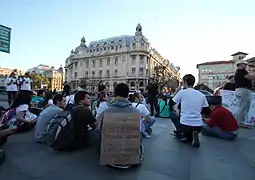
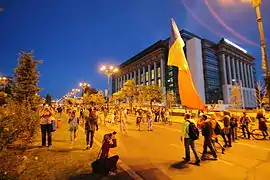
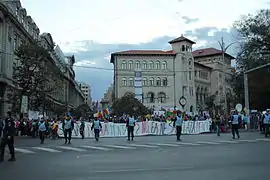
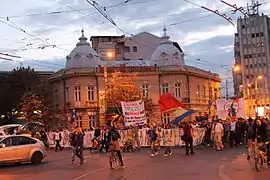
.jpg.webp)